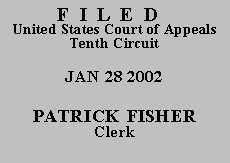

| JIMMY LYN FARRELL,
Petitioner-Appellant, |
|
| v. | |
| MIKE ADDISON, Warden,
Respondent-Appellee. |
|
Petitioner Jimmy Lyn Farrell, an Oklahoma state prisoner appearing pro se, seeks a certificate of appealability (COA) to challenge the district court's dismissal of his 28 U.S.C. § 2254 habeas petition. Because Farrell has failed to make a "substantial showing of the denial of a constitutional right" as required by 28 U.S.C. § 2253(c)(2), we deny his request for a COA and dismiss the appeal.
Farrell was convicted of operating a motor vehicle while under the influence of alcohol (Count I) and driving under suspension (Count II). He was sentenced to ten years' imprisonment and assessed a $5,000 fine on Count I, and was sentenced to one year imprisonment and assessed a $500 fine on Count II. In his direct appeal, Farrell asserted (1) his sentences were excessive, (2) the trial court improperly admitted testimony from one of the arresting officers regarding his refusal to take a sobriety test, and (3) the prosecutor asked improper questions of witnesses and made improper and prejudicial comments during closing arguments, all of which caused the jury to decide the case based on emotions. The Oklahoma Court of Criminal Appeals (OCCA) affirmed his convictions and sentences.
In his federal habeas petition, Farrell asserted the same issues raised in his direct appeal, as well as several other issues not presented to the OCCA. The magistrate judge concluded the OCCA had reasonably rejected the three issues raised by Farrell in his direct appeal, and that the remaining issues were procedurally barred for failure to raise them on direct appeal. The district court accepted the magistrate's recommendation and dismissed Farrell's habeas petition.
As regards Farrell's application for a COA, we are unable to conclude the district court's assessment of the three issues raised by Farrell on direct appeal was "debatable or wrong." See Slack v. McDaniel, 529 U.S. 473, 484 (2000). We are in substantial agreement with the careful analysis of those claims in the magistrate's written recommendation filed April 27, 2001, which was adopted by the district court on August 7, 2001. As for the remaining claims asserted by Farrell in his appellate brief (the trial court's refusal to call witnesses in his defense, and the prosecutor's presence in the jury room during deliberations), we conclude no appeal is warranted since "a plain procedural bar is present and the district court [wa]s correct to invoke it to dispose of the case." Id. As noted by the magistrate, the OCCA would consider these claims procedurally barred if Farrell attempted to raise them now in an application for post-conviction relief. Thus, those claims are considered procedurally defaulted for purposes of federal habeas review. See Thomas v. Gibson, 218 F.3d 1213, 1221 (10th Cir. 2000) ("[I]f a petitioner failed to exhaust state remedies and the court to which the petitioner would be required to present his claims in order to meet the exhaustion requirement would now find the claims procedurally barred[,] the claims are considered exhausted and procedurally defaulted for purposes of federal habeas relief.") (internal quotations omitted). Finally, Farrell has failed to establish cause and prejudice sufficient to excuse his failure to exhaust the issues, or that a fundamental miscarriage of justice would result if the issues were not addressed. See Edwards v. Carpenter, 529 U.S. 446, 451 (2000).
Farrell's request for a certificate of appealability is DENIED and the appeal is DISMISSED. The request to proceed on appeal in forma pauperis is denied as moot since the district court has granted the request. The mandate shall issue forthwith.
Entered for the Court
Mary Beck Briscoe
Circuit Judge
*.This order and judgment is not binding precedent, except under the doctrines of law of the case, res judicata, and collateral estoppel. The court generally disfavors the citation of orders and judgments; nevertheless, an order and judgment may be cited under the terms and conditions of 10th Cir. R. 36.3.